Proposal for an Experimental Methodology for Evaluation of Natural Lighting Systems Applied in Buildings
Abstract
:1. Introduction
2. Materials and Methods
2.1. Characteristics of Natural Lighting Systems
2.2. Validation System
2.3. Data Acquisition
3. Results and Discussion
4. Conclusions
Acknowledgments
Author Contributions
Conflicts of Interest
References
- Assessment of Feasibility of a Hydroelectric Power Generation Project. 2004. 142 f. Monograph (Lato Sensu)—Course of Economic Science. Available online: http://www.aneel.gov.br/documents/656835/14876412/Monografia_Erik_Eduardo.pdf/e2240dc6-0b79-459e-9466-5c31bdc6c400 (accessed on 30 June 2017).
- Brazilian National Electricity Agency. Available online: http://www2.aneel.gov.br/arquivos/pdf/atlas3ed.pdf (accessed on 30 June 2017).
- Projection of Electricity Demand: For the Next 5 Years (2016–2020). Available online: http://www.epe.gov.br/mercado/Documents/S%C3%A9rie%20Estudos%20de%20Energia/DEA%2019-15%20-%20Proje%C3%A7%C3%B5es%20da%20Demanda%20de%20Energia%20El%C3%A9trica%202016-2020.pdf (accessed on 30 June 2017).
- MME, Ministry of Mines and Energy, and EPE Energy Research Company. National Energy Balance—Base Year Base 2014. Brasília, 2015. Available online: https://ben.epe.gov.br/BENRelatorioFinal.aspx?anoColeta=2014&anoFimColeta=2013 (accessed on 30 June 2017).
- Brazilian Atlas of Solar Energy. São José dos Campos. Available online: http://ftp.cptec.inpe.br/labren/publ/livros/brazil_solar_atlas_R1.pdf (accessed on 30 June 2017). (In Portuguese).
- Ando Junior, O.H.; Rosa, H.B.; Spacek, A.D.; Malfatti, C.F.; Schaeffer, L. Proposal of an alternative system for capturing low-cost sunlight for insertion in the Brazilian market. Ciência Tecnologia dos Materiais 2014, 26, 17–24. [Google Scholar]
- General Guidelines for the Conservation of Electrical Energy in Buildings. Available online: https://organizacaotc.files.wordpress.com/2014/04/ceee1.pdf (accessed on 30 June 2017).
- Heating, Cooling, Lighting: Design Methods for Architects. 2nd Edition. Available online: http://www.academia.edu/8577865/Heating_Cooling_Lighting_Sustainable_Design_Methods_for_Architects_4th (accessed on 30 June 2017).
- Soto, S.F.J. Evaluation of Light Duct Luminaire Performance: Study of the Implementation in Standard Environments of Popular Housing in Three Latitudes. Master’s Thesis, Federal University of Alagoas, Maceió, Brazil, 2010. [Google Scholar]
- Li, D.H.W.; Tsang, E.K.W.; Cheung, K.L.; Tam, C.O. An Analysis of Light-pipe System via Full-scale Measurements. Appl. Energy 2010, 87, 799–805. [Google Scholar] [CrossRef]
- Mohelnikova, J. Tubular Light Guide Evaluation. Build. Environ. 2009, 44, 2193–2200. [Google Scholar] [CrossRef]
- SOLATUBE. Available online: http://www.solatube.com (accessed on 30 June 2017).
- Swift, P.D.D.; Smith, G.B. Cylindrical mirror light pipes. Sol. Energy Mater. Sol. Cells 1995, 36, 159–168. [Google Scholar] [CrossRef]
- Al-Marwaee, M.; Carter, D. Tubular guidance systems for daylight: Achieved and predicted installation performances. Appl. Energy 2006, 83, 774–788. [Google Scholar] [CrossRef]
- Özgün, Ö. Tubular Light Guidance Systems As Advanced Daylighting Strategy; Istambul Technical University: Istanbul, Turkey, 2007. [Google Scholar]
- Swift, P.D.; Lawlor, R.; Smith, G.B.; Gentle, A. Rectangular-section mirror light pipes. Elsevier Sol. Energy Mater. Sol. Cells 2008, 92, 969–975. [Google Scholar] [CrossRef]
- Kocifaj, M. Analytical solution for daylight transmission via hollow light pipes with a transparent glazing. Sol. Energy 2009, 83, 186–192. [Google Scholar] [CrossRef]
- Swift, P.D. Splayed mirror light pipes. Sol. Energy 2010, 84, 160–165. [Google Scholar] [CrossRef]
- Edmonds, I. Transmission of mirror light pipes with triangular, rectangular, rhombic and hexagonal cross section. Sol. Energy 2010, 84, 928–938. [Google Scholar] [CrossRef]
- Kim, J.T.; Kim, G. Overview and new developments in optical daylighting systems for building a healthy indoor environment. Build. Environ. 2010, 45, 256–269. [Google Scholar] [CrossRef]
- Lo Verso, V.R.M.; Pellegrino, A.; Serra, V. Light transmission efficiency of daylight guidance systems: An assessment approach based on simulations and measurements in a sun/sky simulator. Sol. Energy 2011, 85, 2789–2801. [Google Scholar] [CrossRef]
- Malet-Damour, B.; Boyer, H.; Fakra, A.H.; Bojic, M. Light Pipes Performance Prediction: Inter Model and Experimental Confrontation on Vertical Circular Light-guides. Energy Procedia 2014, 57, 1977–1986. [Google Scholar] [CrossRef]
- Gil-Martín, L.M.; Peña-García, A.; Jiménez, A.; Hernández-Montes, E. Study of light-pipes for the use of sunlight in road tunnels: From a scale model to real tunnels. Tunn. Undergr. Space Technol. 2014, 41, 82–87. [Google Scholar] [CrossRef]
- Šikula, O.; Mohelníková, J.; Plášek, J. Thermal analysis of light pipes for insulated flat roofs. Energy Build. 2014, 85, 436–444. (In Portuguese) [Google Scholar]
- Mayhoub, M.S. Innovative daylighting systems’ challenges: A critical study. Energy Build. 2014, 80, 394–405. [Google Scholar] [CrossRef]
- Wang, S.; Zhao, J.; Wang, L. Research on energy saving analysis of tubular daylight devices. Energy Procedia 2015, 78, 1781–1786. [Google Scholar]
- Pirasaci, T. Investigation of laminar natural convection heat transfer within tubular daylighting devices for winter conditions. J. Build. Eng. 2015, 4, 52–59. [Google Scholar] [CrossRef]
- Ciugudeanu, C.; Beu, D. Passive Tubular Daylight Guidance System Survey. Procedia Technol. 2016, 22, 690–696. [Google Scholar] [CrossRef]
- Malet-Damour, B.; Guichard, S.; Bigot, D.; Boyer, H. Study of tubular daylight guide systems in buildings: Experimentation, modelling and validation. Energy Build. 2016, 129, 308–321. [Google Scholar] [CrossRef]
- ABNT—Brazilian Association of Technical Standards. NBR ISO/CIE 8995-1: Lighting of Work Environments. Part 1: Internal. Available online: https://www.target.com.br/pesquisa/resultado.aspx?pp=16&c=43005 (accessed on 30 June 2017). (In Portuguese).
- Spacek, A.D.; de Santana, M.V.F.; Mota, J.M.; Biléssimo, L.D.; Ando Junior, O.H.; Freitas, G.P.; Pereira, T.C. Estimated Environments Lighting Capacity Through Sunlight. Available online: http://dx.doi.org/10.24084/repqj14.363 (accessed on 30 June 2017).
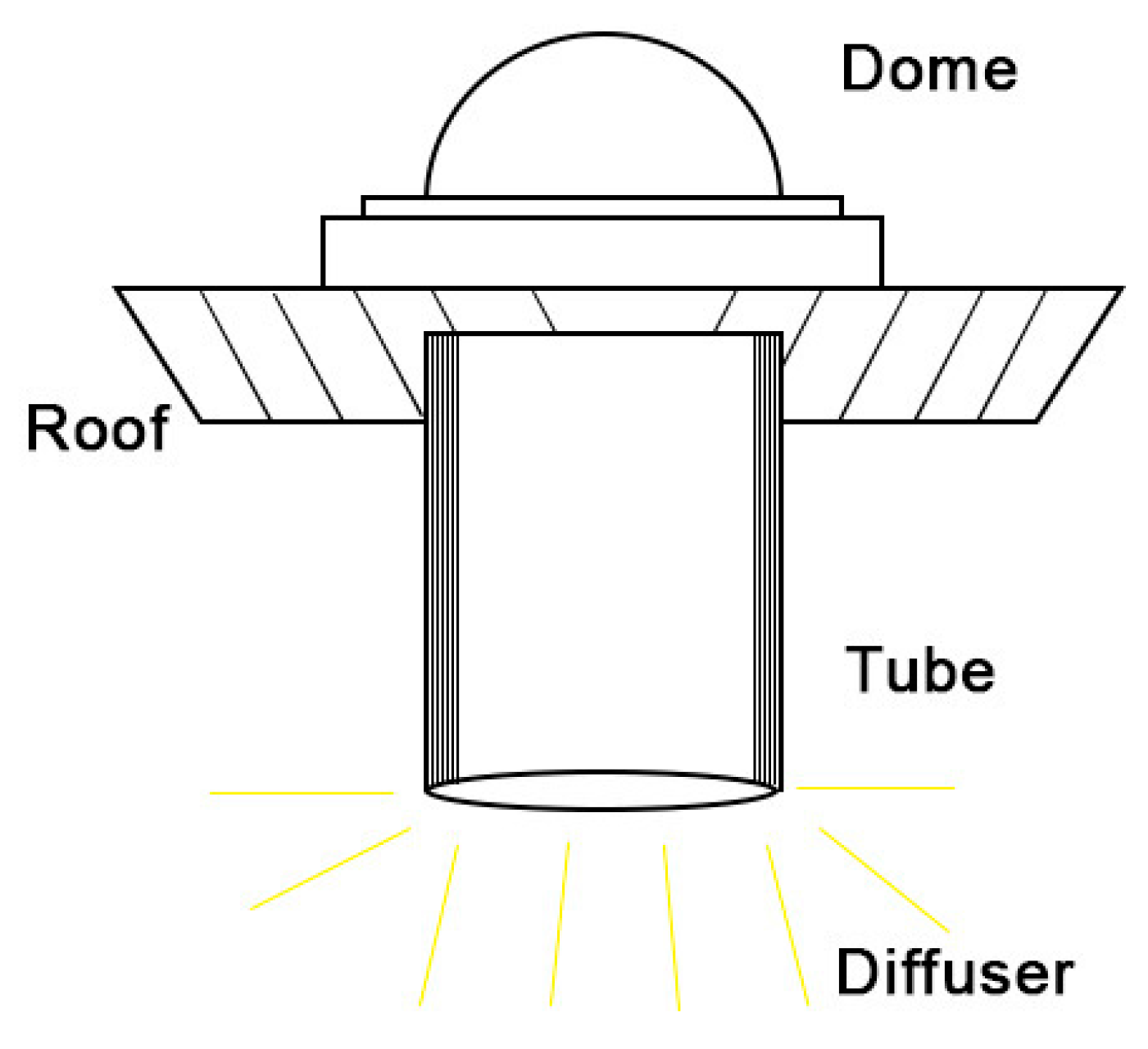
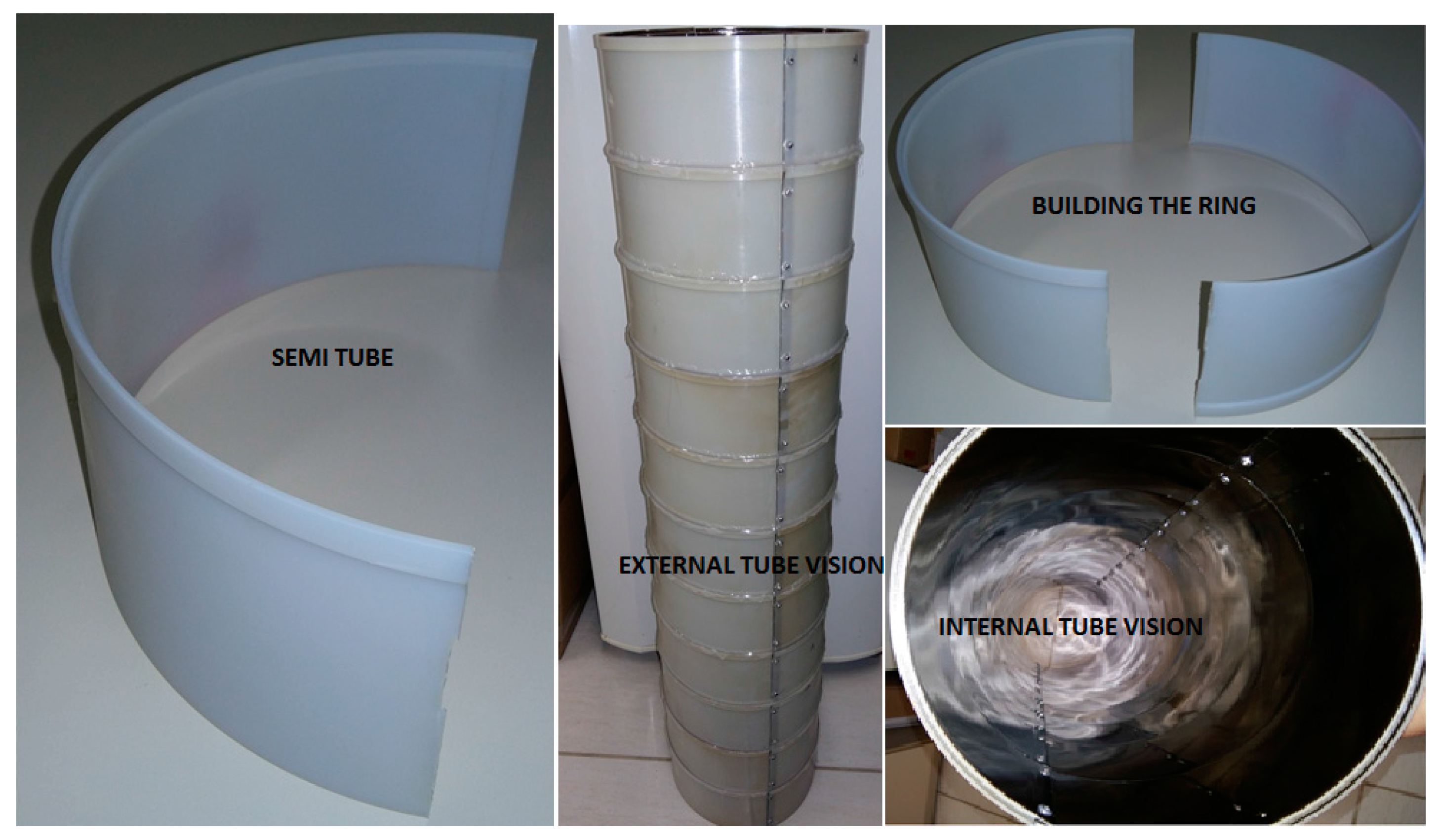
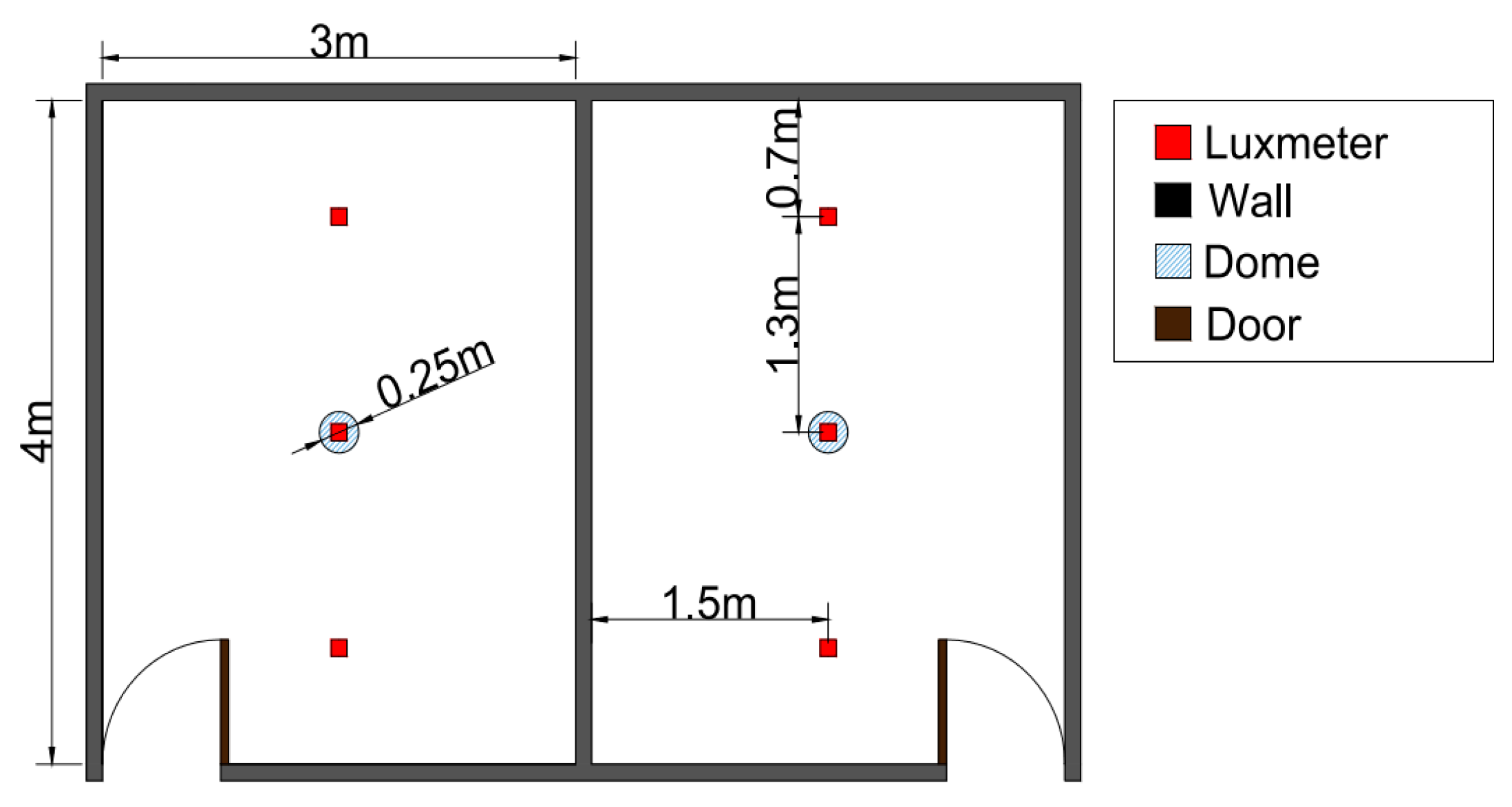

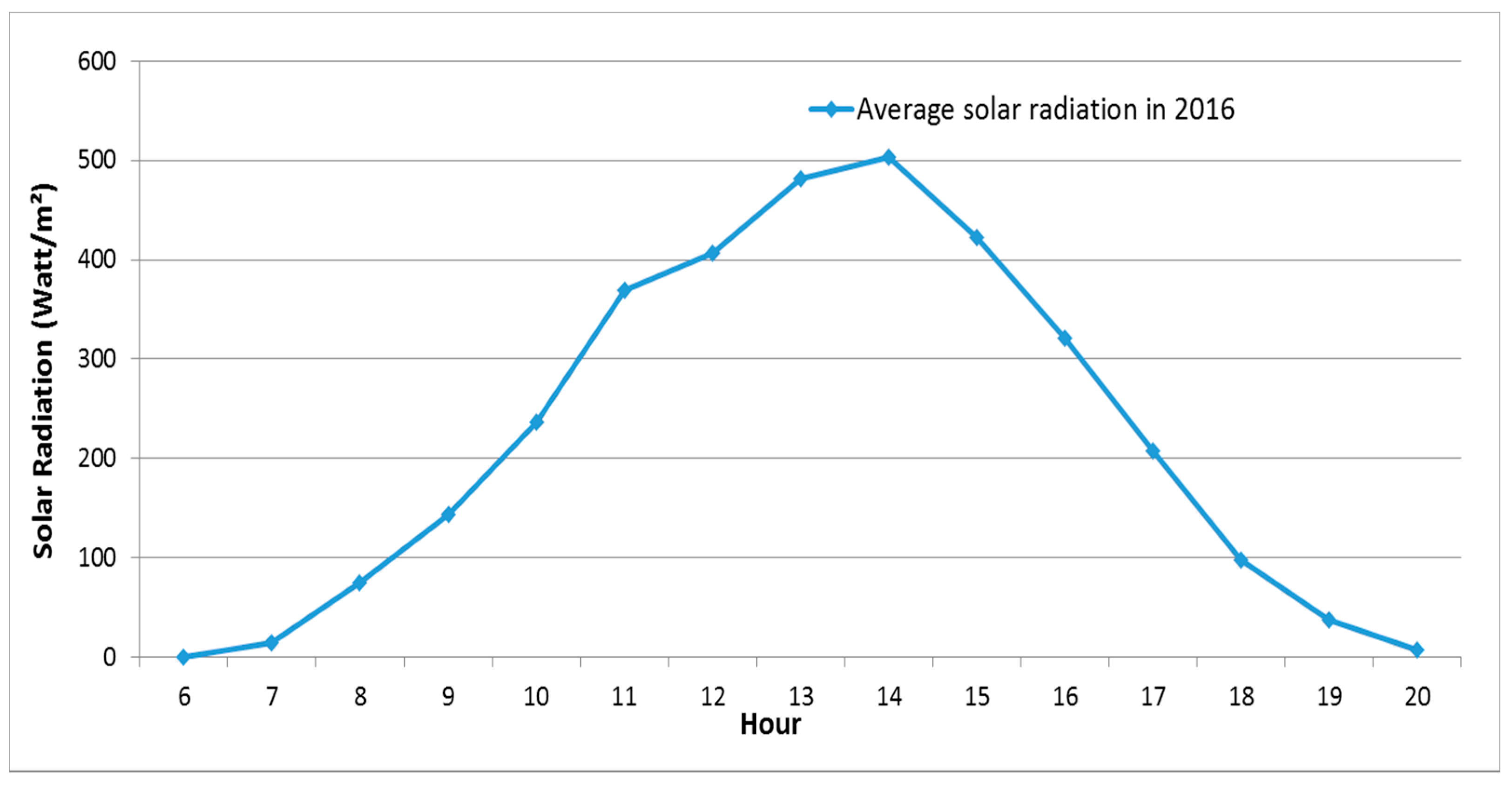
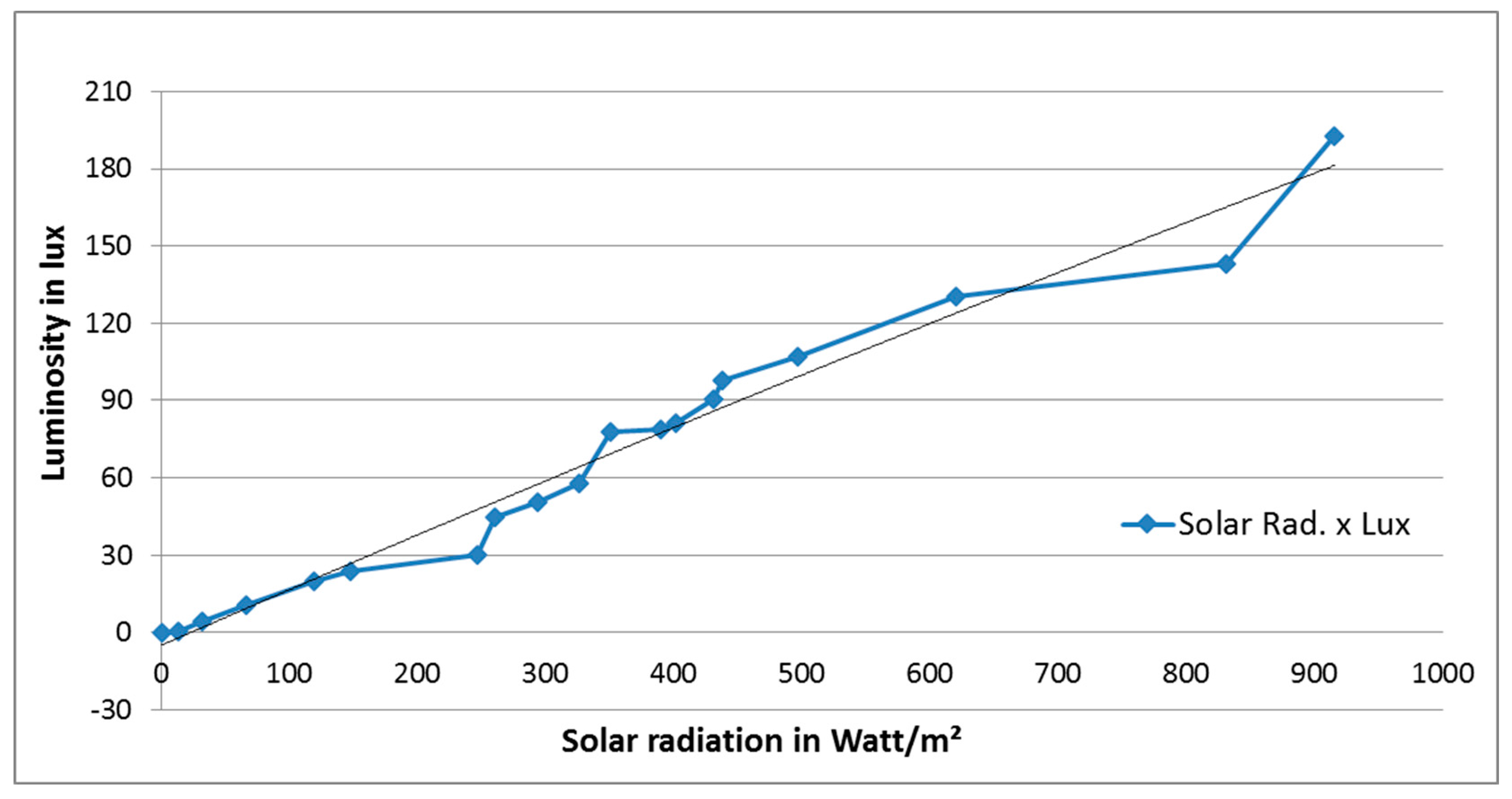
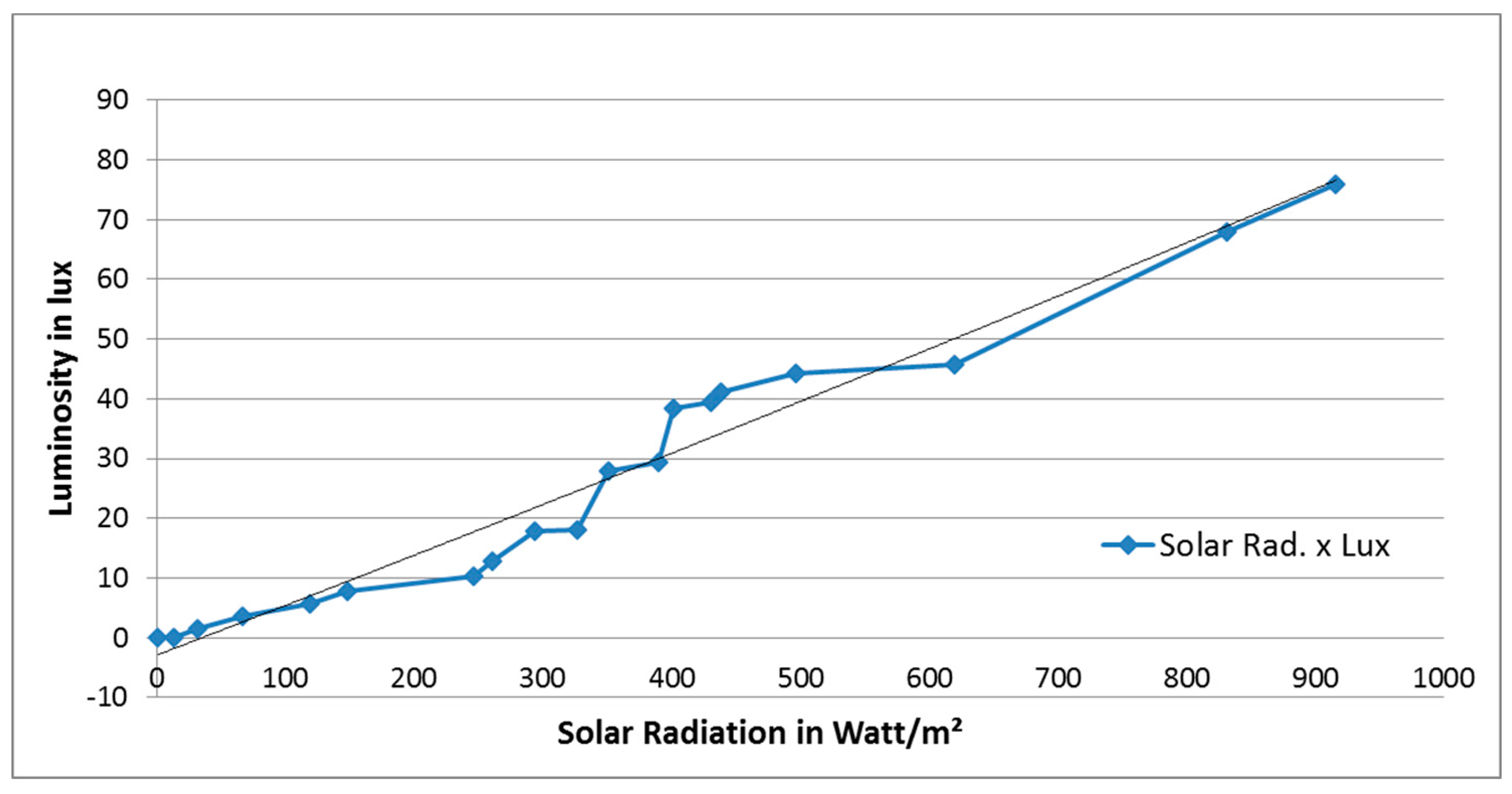
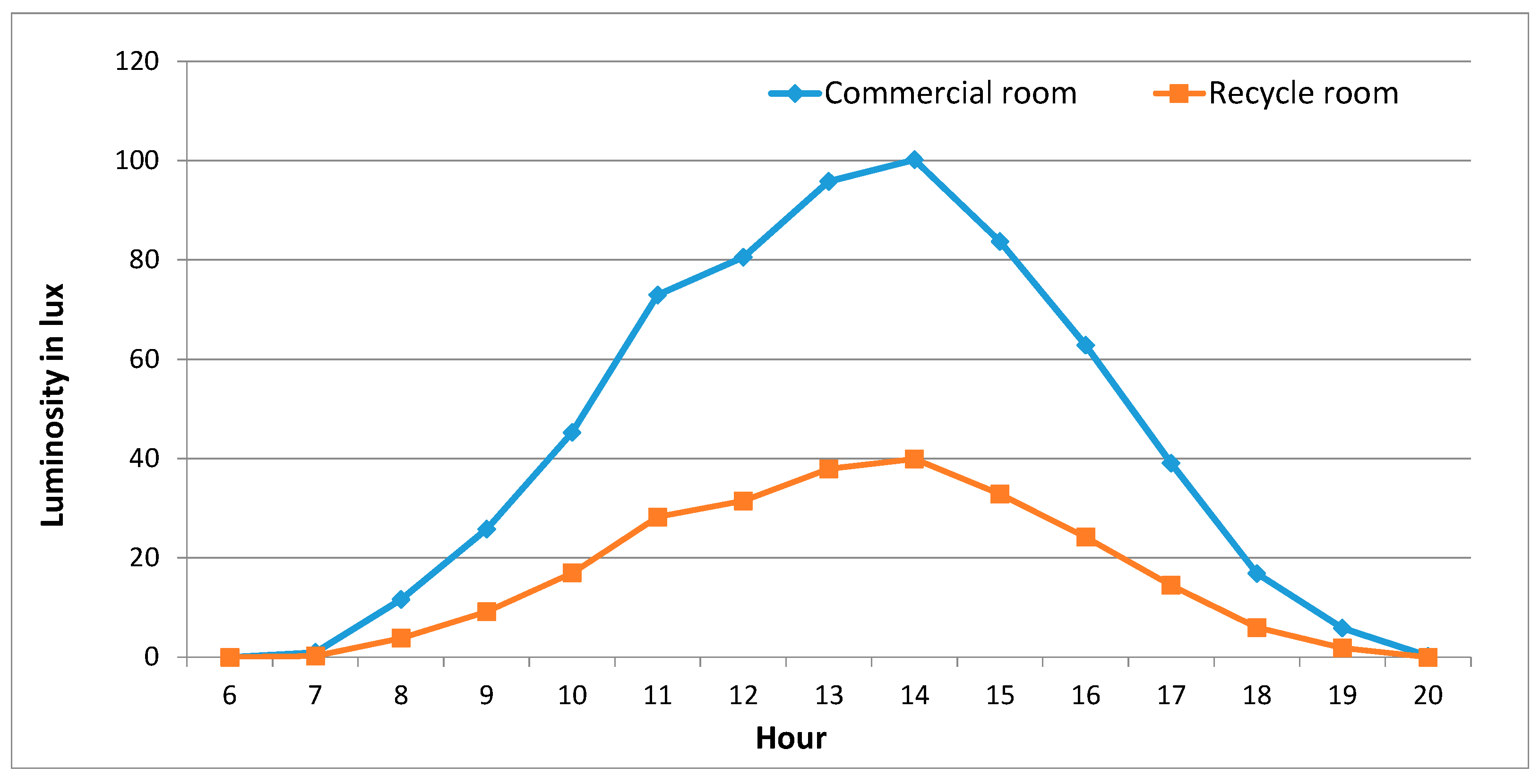
| Manufacturer | Reflective Tube Material | Nominal Reflection |
|---|---|---|
| Espacio Solar (Spain) | Aluminum with silver coating | 98% |
| Velux (Portugal) | Highly reflective aluminum | 99% |
| Fakro (Portugal) | Aluminum with silver coating | 98% |
| Natural light tubular skylights (USA) | Aluminum with silver coating | 98% |
| SOLATUBE (Australia) | Aluminum with silver coating | 99.7% |
| Chatron (Portugal) | Aluminum with silver coating | 99.7% |
| Solarspot (Italy) | Highly reflective aluminum | 99.7% |
| Title | Information |
|---|---|
| Cylindrical mirror light pipes [13] | Evaluation of reflectivity in solar tubes from integrative sphere analysis |
| Tubular guidance systems for daylight: Achieved and predicted installation performances [14] | Critical review of existing zenith lighting methods |
| Tubular light guidance systems as advanced daylighting strategy [15] | Evaluation of tubular lighting systems using SkyVision software and other software with the same function |
| Rectangular-section mirror light pipes [16] | Modeling of rectangular reflective systems with integrative sphere |
| Analytical solution for daylight transmission via hollow light pipes with a transparent glazing [17] | Modeling of light transmission in solar tubes |
| Splayed mirror light pipes [18] | Modeling of rectangular reflective systems |
| Transmission of mirror light pipes with triangular, rectangular, rhombic and hexagonal cross section [19] | Definition of expressions for calculation of light transmission in reflective, triangular, rhombohedral and hexagonal rectangular systems |
| Overview and new developments in optical daylighting systems for building a healthy indoor environment [20] | Overview of two optical natural lighting systems (tube light systems and mirror systems) |
| Light transmission efficiency of daylight guidance systems: An assessment approach based on simulations and measurements in a sun/sky simulator [21] | Characterization of the photometric performance of tubular light guidance systems in terms of light |
| Light Pipes Performance Prediction: inter model and experimental confrontation on vertical circular light-guides [22] | Modeling and experimental analysis of vertical solar tubes |
| Study of light-pipes for the use of sunlight in road tunnels: From a scale model to real tunnels [23] | Evaluation of the application of light tubes in tunnel lighting |
| Thermal analysis of light pipes for insulated flat roofs [24] | Thermal analysis of solar tubes used in roofs |
| Innovative daylighting systems challenges: A critical study [25] | Analysis of existing natural light utilization technologies |
| Research on energy saving analysis of tubular daylight devices [26] | Presentation of a model for evaluating the efficiency of tubular systems |
| Investigation of laminar natural convection heat transfer within tubular daylighting devices for winter conditions [27] | Experimental and numerical study on natural laminar convection in TDD for winter conditions |
| Passive Tubular Daylight Guidance System Survey [28] | Case study of the installation of a TDGS in Cluj-Napoca (Romania) |
| Study of tubular daylight guide systems in buildings: Experimentation, modelling and validation [29] | Proposition of a new model of analysis more precise to validate the TDGS in efficacies |
| Characteristics of Reflexive Tubes | |||||
|---|---|---|---|---|---|
| External Material | Internal Material | Diameter (mm) | Length (mm) | Weight (Kg) | |
| Commercial (Solatube 160DS) | Aluminum 99% | High-purity silver (Vacuum Metallization) | 250 | 1800 | 2.2 |
| Prototype | Recycled polypropylene | Aluminum (Vacuum Metallization) | 250 | 1800 | 2.9 |
| Hour | 06:00 | 07:00 | 08:00 | 09:00 | 10:00 | 11:00 | 12:00 |
|---|---|---|---|---|---|---|---|
| Standard Tube | 0.00 | 4.11 | 19.85 | 44.45 | 57.82 | 81.18 | 97.99 |
| Recycle Tube | 0.00 | 1.55 | 5.70 | 12.75 | 17.91 | 27.94 | 38.39 |
| Solar Rad. | 0.60 | 31.70 | 119.30 | 260.80 | 326.30 | 350.90 | 390.10 |
| Hour | 13:00 | 14:00 | 15:00 | 16:00 | 17:00 | 18:00 | 19:00 | 20:00 |
|---|---|---|---|---|---|---|---|---|
| Standard Tube | 77.60 | 90.57 | 78.64 | 50.62 | 29.89 | 23.97 | 10.43 | 0.46 |
| Recycle Tube | 41.02 | 39.50 | 29.32 | 18.05 | 10.24 | 7.70 | 3.61 | 0.16 |
| Solar Rad. | 430.90 | 438.30 | 401.70 | 294.20 | 246.40 | 147.90 | 66.50 | 13.50 |
© 2017 by the authors. Licensee MDPI, Basel, Switzerland. This article is an open access article distributed under the terms and conditions of the Creative Commons Attribution (CC BY) license (http://creativecommons.org/licenses/by/4.0/).
Share and Cite
Spacek, A.D.; Neto, J.M.; Biléssimo, L.D.; Junior, O.H.A.; Neto, G.P.D.F.; Giansella, R.D.S.; Santana, M.V.F.D.; Malfatti, C.D.F. Proposal for an Experimental Methodology for Evaluation of Natural Lighting Systems Applied in Buildings. Energies 2017, 10, 1014. https://doi.org/10.3390/en10071014
Spacek AD, Neto JM, Biléssimo LD, Junior OHA, Neto GPDF, Giansella RDS, Santana MVFD, Malfatti CDF. Proposal for an Experimental Methodology for Evaluation of Natural Lighting Systems Applied in Buildings. Energies. 2017; 10(7):1014. https://doi.org/10.3390/en10071014
Chicago/Turabian StyleSpacek, Anderson Diogo, João Mota Neto, Luciano Dagostin Biléssimo, Oswaldo Hideo Ando Junior, Gustavo Pedro De Freitas Neto, Rodrigo Da Silva Giansella, Marcus Vinícius Ferreira De Santana, and Celia De Fraga Malfatti. 2017. "Proposal for an Experimental Methodology for Evaluation of Natural Lighting Systems Applied in Buildings" Energies 10, no. 7: 1014. https://doi.org/10.3390/en10071014






